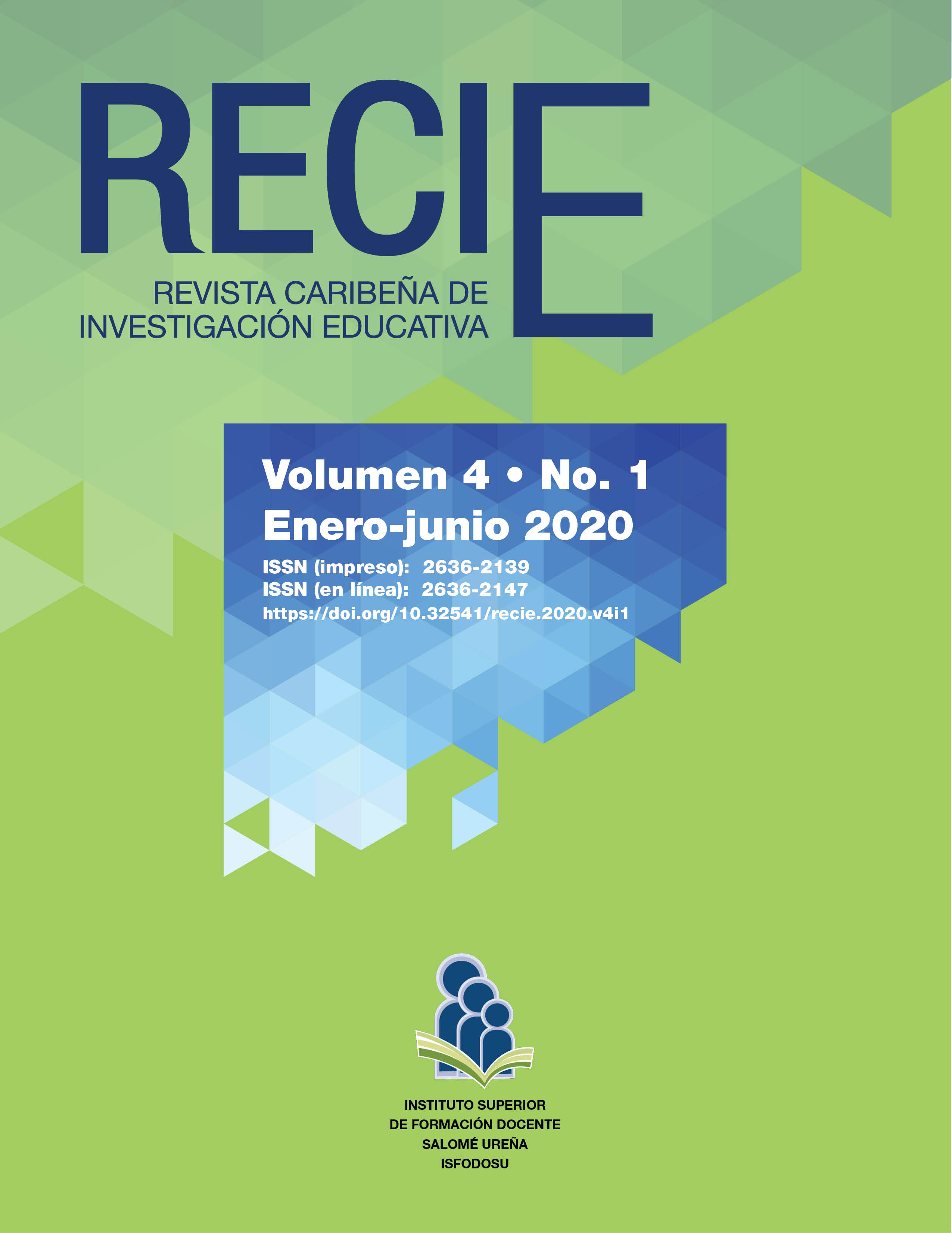Acceptance of Gender-Based Violence by Public School Teachers
Authors
Aída Mencía-Ripley
Universidad Iberoamericana, República Dominicana
[email protected] https://orcid.org/0000-0001-7510-4072Detalles
Published
Abstract
Gender-Based Violence (GBV) is a problem in education and health systems across Latin America. The Dominican Republic consistently shows high rates across several types of GBV. Due to the aforementioned reasons, this study explores how the acceptance of three types of GBV impacts the beliefs of primary school teachers regarding the abilities of girls and boys in different academic disciplines. The subjects are Reading and Writing, Mathematics, Science, and Physical Education. In the Dominican Republic, the response to GBV is typically reactive to specific events of victimization. There is little local data on the cognitions and attitudinal barriers to violence prevention that allow scientists to identify change and preventive school-based programs. Through a prospective, cross-sectional, correlational study design, we found that teachers generally accept myths or stereotypes about GBV generally blaming women for their victimization. Similarly, they accept stereotypes about academic skills based on the female or male gender, especially for Mathematics, for which the model explained 12% of the variance. This study indicates that the educational environment not only replicates social inequalities, but that these biases also impact the assessments students receive form their teachers.
Keywords
Downloads
Metrics
References
Barquín Ruiz, J., & Melero Zabal, M. (1994). Feminización y profesión docente: Internalización sexista del trabajo. Revista de Investigación en la Escuela, 22, 25-34.
Barredo Ibáñez, D., Liberia Vayá, I., Macías Cruzatty, A., Palomeque Guillén, V., Delgado Burgos,
M. Á., Zurbano-Berenguer, B., Espinoza-Lucas, M., García García, M. E., & Cedeño Delgado, G. (2014). Actitudes y percepciones sobre la violencia de género del personal docente y administrativo y de servicios de Manta: estudio del Colegio 5 de Junio (2014). Revista San Gregorio, 1, 38-45. https://bit.ly/32urG4f
Beilock, S. L., Gunderson, E. A., Ramirez, G., & Levine, S. C. (2010). Female teachers’ math anxiety affects girls’ math achievement. Proceedings of the National Academy of Sciences, 107(5), 1860-1863. https://doi.org/10.1073/pnas.0910967107
Carli, L. L., Alawa, L., Lee, Y., Zhao, B., & Kim, E. (2016). Stereotypes about gender and science: Women? scientists. Psychology of Women Quarterly, 40(2), 244-260. https://doi.org/10.1177/0361684315622645
Eagly, A.H., & Miller, D. I. (2016). Scientific Eminence: Where are the women? Perspectives on Psychological Science, 11(6), 899-904. https://doi.org/10.1177/1745691616663918
Friedrich, A., Flunger, B., Nagengast, B., Jonkmann, K., & Trautwein, U. (2015). Pygmalion effects in the classroom: Teacher expectancy effects on students’ math achievement. Contemporary Educational Psychology, 41, 1-12. https://doi.org/10.1016/j.cedpsych.2014.10.006
Expósito, F., Herrera, A., Valor-Segura, I., Herrera, M. C., & Lozano, L. M. (2014). Spanish adaptation of the Illinois sexual harassment myth acceptance. The Spanish Journal of Psychology, 17. https://doi.org/10.1017/sjp.2014.42
Glick, P., & Fiske, S. T. (2001). An ambivalent alliance: Hostile and benevolent sexism as complementary justifications for gender inequality. American psychologist, 56(2), 109. https://doi.org/10.1037/0003-066X.56.2.109
Heise, L., Ellsberg, M., & Gottmoeller, M. (2002). A global overview of gender based violence. International Journal of Gynecology & Obstetrics, 78, S5-S14. https://doi.org/10.1016/S0020-7292(02)00038-3
Henry, F. (2015). Survey of Women in the Academies of the Americas. Interamerican Network of Academies of Sciences. https://bit.ly/32A1y8p
López Ojeda, E. (2006). Análisis sociolingüístico: pautas de observación y análisis del sexismo. Los materiales educativos. Interlingüística, (17), 630-639. https://bit.ly/2R9C2V3
McMahon, S., & Farmer, G. L. (2011). An updated measure for assessing subtle rape myths. Social Work Research, 35(2), 71-81. https://doi.org/10.1093/swr/35.2.71
Mencía-Ripley, A., Sánchez-Vincitore, G., Garrido, L., & Aguasvivas, J. (2015). USAID-Leer Baseline
Report. https://bit.ly/2NMXhsw
Mingo, A. (2010). Ojos que no ven...Violencia escolar y género. Perfiles Educativos, 32(130), 25-48.
National Sexual Violence Resource Center (NSVRC) (2015). Statistics about Sexual Violence.
http://bit.ly/2kVs2kE
Pérez Martínez, V. T., & Hernández Marín, Y. (2009). La violencia psicológica de género, una forma encubierta de agresión. Revista Cubana de Medicina General Integral, 25(2).
Peters, J. (2008). Measuring myths about domestic violence: Development and initial validation of the domestic violence myth acceptance scale. Journal of Aggression, Maltreatment & Trauma, 16(1), 1-21. https://doi.org/10.1080/10926770801917780
Piedra, J., García Pérez, R., Fernández García, E., & Rebollo, M.A. (2014). Brecha de género en educación física: Actitudes del profesorado hacia la igualdad. Revista Internacional de Medicina y Ciencias de la Actividad Física y el Deporte, 14 (53), 1-21. https://bit.ly/2WV9xLK
Plan Internacional República Dominicana (2017). Niñas Esposadas. Caracterización del matrimonio infantil forzado en las provincias de Azua, Barahona, Pedernales, Elías Piña y San Juan. Planteamientos (2), 1-32. https://bit.ly/33xcvIS
Roberts, R. E., Phinney, J. S., Masse, L. C., Chen, Y. R., Roberts, C. R., & Romero, A. (1999). The structure of ethnic identity of young adolescents from diverse ethnocultural groups. The Journal of Early Adolescence, 19(3), 301-322.
https://doi.org/10.1177%2F0272431699019003001 Sánchez-Díaz, L. Street harassment perception and it relations with self-objectification of women. INTERdisciplina, 7(17), 153-170. https://doi.org/10.22201/ceiich.24485705e.2019.17.67534
Sánchez-Vincitore, L.V., Garrido, L.E., Martínez, L., & Mencía-Ripley, A. (2017). End of Second Grade Reading Assessment of USAID’s Read Project: Academic Year 2016-2017. https://bit.ly/2CtjQgR
Smith, T. B., & Silva, L. (2011). Ethnic identity and personal well-being of people of color: A meta-analysis. Journal of Counseling Psychology, 58(1), 42. https://doi.org/10.1037/a0021528
Süssenbach, P., Eyssel, F., Rees, J., & Bohner, G. (2017). Looking for blame: Rape myth acceptance and attention to victim and perpetrator. Journal of interpersonal violence, 32(15), 2323-2344. https://doi.org/10.3389/fpsyg.2018.02690
Süssenbach, P., Eyssel, F., Rees, J., & Bohner, G. (2017). Looking for blame: Rape myth acceptance and attention to victim and perpetrator. Journal of interpersonal violence, 32(15), 2323-2344. https://doi.org/10.1177%2F0886260515591975
Van Mier, H. I., Schleepen, T. M. J., & Van den Berg, F. C. G. (2018). Gender Differences Regarding the Impact of Math Anxiety on Arithmetic Performance in Second and Fourth Graders. Frontiers in Psychology, 9, 2690. https://doi.org/10.3389/fpsyg.2018.02690
